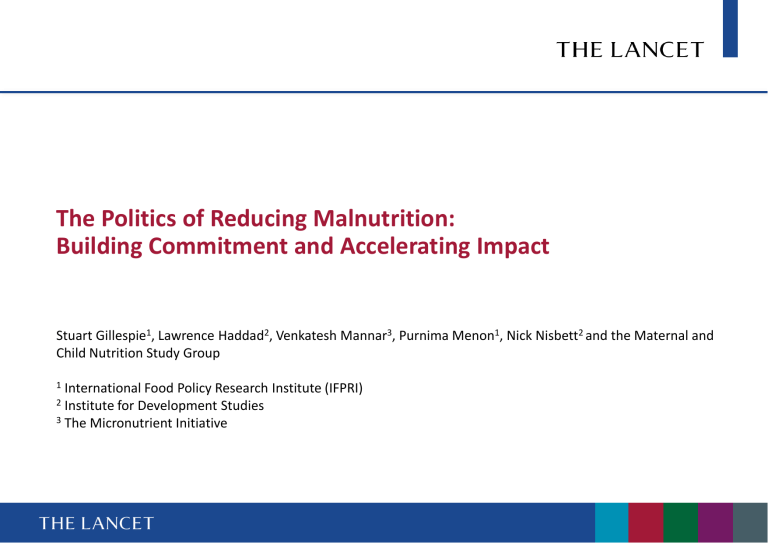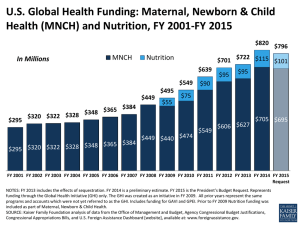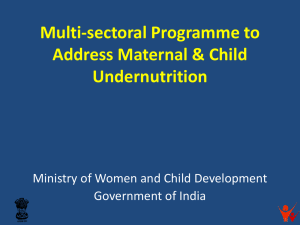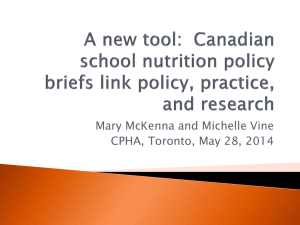LNS2 Paper 4 Slides London FINAL

The Politics of Reducing Malnutrition:
Building Commitment and Accelerating Impact
Stuart Gillespie 1 , Lawrence Haddad 2 , Venkatesh Mannar 3 , Purnima Menon 1 , Nick Nisbett 2 and the Maternal and
Child Nutrition Study Group
3
2
1 International Food Policy Research Institute (IFPRI)
Institute for Development Studies
The Micronutrient Initiative
The Politics of Reducing Malnutrition:
Building Commitment and Accelerating Impact
2
Shifts in the Nutrition Landscape
2008
• Stewardship of the nutrition system dysfunctional and deeply fragmented
• New evidence base introduced in the
2008 Lancet Series, identified critical
1,000 day window
• Pinpointed a package of highly effective interventions for reducing undernutrition
• Proposed a group of “high burden” countries as priorities for increased investment
2013
• Nutrition significantly elevated on the global agenda
• Launch of the Scaling Up Nutrition (SUN)
Movement in 2010: a major step toward improved stewardship of nutrition architecture
• Nearly every major development agency has published a policy document on undernutrition
• Donors have increased ODA to basic nutrition by more than 60 percent between 2008 and 2011, amidst a very difficult fiscal climate
• Nutrition is now more prominent on the agendas of the United Nations, the G8 and G20 and supporting civil society
3
The Challenges
To maintain global commitment
To accelerate country level commitment
To convert commitment into action
To accelerate improvements in nutrition status
Improvements in nutrition status are lagging behind economic growth
4
A More Collective Approach is Needed
A “whole of society” approach to combine resources and knowhow
• Beyond government, e.g. business and civil society
• Beyond the usual sectors, e.g. education and ICT
Need to create an “enabling environment” for nutrition
• Enable these actors to come together
• Enable the emergence of new champions
• Incentivise them to do the right things for nutrition
5
Characterising Enabling Environments
What does an enabling environment for undernutrition reduction look like?
Three vital factors for creating momentum and converting it to impact:
Framing, knowledge and evidence
Politics and governance
Capacity and financial resources
Impact
6
Key Features of an Enabling Environment
New Framing and Evidence
• To draw actors in and show they can make a contribution
Politics and Governance
• To understand and navigate competing agendas
• To make the stakeholders’ commitments to nutrition visible and to promote accountability
Human and Financial Resources
• To coordinate actions and to deliver, effectively, at scale
7
Nutrition Narratives
• Nutrition for Growth
• Supercharging the Demographic Dividend
• Nourishing Minds
• Child Survival
• Hidden Hunger
• The First Step in Preventing NCDs in later life
Narratives need to be backed up with credible evidence
8
Politics and Governance
Maharashtra
Good cross-sectoral coordination
&
Good cooperation between centre and local levels low
Horizontal coordination high
Malawi,
Peru
9
Commitment to Nutrition is Not the Same as a
Commitment to Hunger Reduction
10
Capacity to Deliver:
Prioritising, Sequencing, Scaling Actions
Individual
• Nutrition needs more leaders
Organisational
• What can one nutrition champion do within an organisation that does not support her?
System
• Are there spaces for stakeholders to come together?
• Are roles clearly defined?
11
Resources for Nutrition:
Look everywhere but be guided by a plan, with checks and balances
Create budget lines,
Increase commitments,
Find nutrition sensitive opportunities
Fortification,
Logistics,
Local innovation
Market purchases
Increase commitments,
Create incentives that leverage high burden
Risk sharing and pooling,
Innovation start ups
Public-only Private-public networks
Resources for Nutrition
Ethical trading
Private-only
12
Paper 4 Key Messages
Enabling environments are needed to bring stakeholders together in harmony for nutrition
Key features of enabling environments for nutrition:
• Collective approach, political approach, accountability strengthened, strengthened capacity at all levels, more creativity around resource mobilisation with stronger checks and balances
Leadership at all levels is fundamentally important – for creating and sustaining momentum and converting it to impact
Operational research on how to scale up and a shift to the “why?” and “how?” as well as the “what” of effectiveness
Undernutrition reduction can be accelerated through deliberate action
Let’s not wait for political will, let’s will our politicians to act
13








